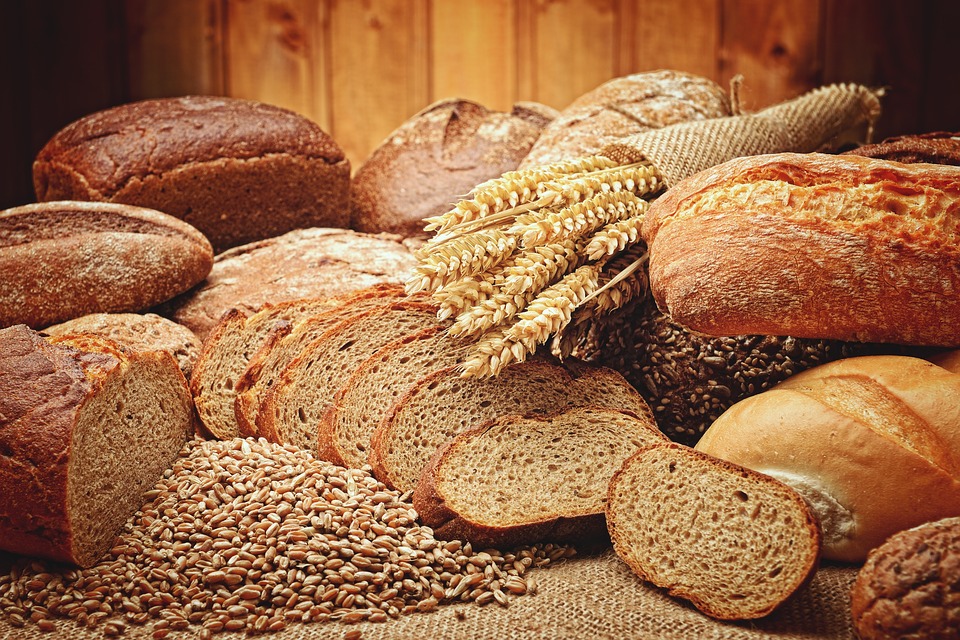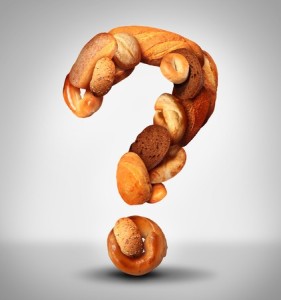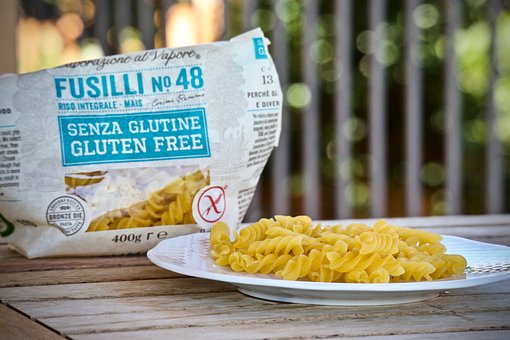Gluten
What is gluten?
Gluten is a group of proteins found in grains like wheat, rye, barley and spelt.
The two main proteins in gluten are glutenin and gliadin. In addition, gliadin is the main culprit with negative health effects with gluten.
What is glutens role?
When flour and water are mixed together the proteins of gluten become glue like and form a sticky network of fibres. These fibres make the dough elastic and gives bread the strength to rise when baked. In the mouth gluten produces a chewy delicious texture.
Most people tolerate gluten well. However, gluten becomes a problem when some people have certain health conditions. For example, celiac disease, gluten sensitivity, wheat allergy and some other diseases.
What is Celiac Disease?
Celiac disease also spelt as Coeliac, is the most severe form of gluten intolerance and affects around 1% of the population. It is an autoimmune disorder and associates the protein in gluten as foreign in which the body’s immune response attacks and damages the lining of the gut wall.
The most common symptoms of celiac disease are digestive discomfort, tissue damage in the small intestine (Ileum), bloating, diarrhoea, constipation, headaches, tiredness, skin rashers, mouth ulcers, depression, weight loss and foul smelling stools.
Celiac disease is difficult to diagnose and around 80% of people don’t even realise they have it.
http://theceliacmd.com/2013/09/gluten-really-culprit-gluten-sensitivity/
What is Non-Celiac Gluten Sensitivity?
Many people who do not test positive to celiac disease may still react negatively to gluten. It is estimated that 13% of people may be sensitive and experience symptoms like diarrhoea, stomach aches, tiredness, bloating, mouth ulcers and depression. Many experts in the field of medicine believe that gluten sensitivity is not really a condition and critically suspect that there may be some adverse effects caused by substances other than gluten.
How do you check for Celiac Disease?
To check for celiac disease you may first be asked to do a blood test. This screens for antibodies, the most common tTG-IgA and if it is positive a further investigation of a tissue biopsy is recommended to confirm these results. This biopsy is then taken from the small intestine which is inspected for damage.
If you don’t have celiac disease the best way to find out if you are sensitive is to start an elimination diet and follow a strict gluten-free diet for a few weeks. After a few weeks re-introduce these foods back slowly into your diet. If you don’t have a reaction then you know it may be something other than gluten.
Avoiding Gluten if you are healthy:
Going gluten-free does not promote health and wellness in fact it actually does the opposite. For example, when avoiding gluten grains like wheat, rye, barley or spelt, it reduces the overall quality of your diet. The most common issue when starting a gluten-free diet is fibre intake and this often declines. Thus, fibre is vital for overall digestive health. In addition, an inadequate consumption of fibre leads to constipation and other bowel problems. And, leaving fibre out of your diet may leave you feeling unsatisfied which can lead to overeating and potential weight gain. While grains aren’t the only source of fibre available, they are beneficial. Furthermore, many people already fall short in receiving the recommended daily requirements of wholefoods depending on gender and age.
Therefore, if following a gluten-free diet whist healthy means avoiding whole grains than this can be especially problematic for you and your health, because whole grains are associated with numerous health benefits, such as heart health. In addition, high intake of whole grains has been associated with reduced risk of cardiovascular disease, some type of cancers, type 2 diabetes, obesity and infections.
If you do have a gluten problem, below is a guide to shopping gluten free.
Your guide to gluten free shopping.
1. Plan ahead:
By knowing which foods contain gluten can save you time. However, in the beginning this can be a little time consuming but will get easier with experience. Below is a list of foods that contain gluten.
Wheat, Rye, Barley, Oats, Spelt and Triticale.
Once you avoid these products and replace them with gluten-free alternatives, shopping for such items becomes second nature.
2. Writing a list:
Naturally gluten free foods include
- Fruits and vegetables
- Lean meat, chicken, fish and seafood. (No marinades
- Nuts
- Eggs
- Herbs fresh and dried
- Quinoa
- Rice and rice products
- Buckwheat
- Polenta
- Dairy
3. Shop:
When you hit the supermarket it is always best to shop the perimeter, this is where you will find the fresh fruit and vegetables, nuts, cold items like dairy, meat and fish. These wholefoods are gluten free but also nutritious and will save you heaps of time reading food labels.
Foods labels to double check as they may contain gluten
Baked beans, pesto, grated cheese, spices, chocolate, gravies, soy sauce, Asian sauces like oyster, chilli and fish, curry paste, pasta sauce and taco shells.
Hidden sources of gluten
Baking powder, Beer, stout, lager, ale, canned soups, confectionery, custard powder, dressings, gravies and sauces, hot chips, hot chocolate, Icing sugar mixture, flavoured milks, margarine (may contain breadcrumbs), some medications, powdered drink flavourings, sausages and processed meats, seasoning, stock cubes and liquid, soy milk, wheaten cornflour and yeast extract spreads.
4. Shop aisles for:
Dried beans, legumes, canned tomatoes, spices, nut milks, rice products like noodles and rice cakes.
5. Gluten free products:
Gluten free does not automatically mean healthy and a way to lose weight. Many gluten free packaged snack foods are high in sugars, sodium and saturated fats to add flavour and low in fibre. In addition, gluten free snacks should be considered discretionary items and only consumed on occasion, such as chips, cakes and biscuits. Therefore, swap gluten free options for nuts, seeds, fresh fruits and dairy products.
How to make your own gluten free flour:
You can make your own flour by combining the following
- 2 cups rice flour, 2/3 cup potato flour and 1/3 cup tapioca flour;
Or
- Equal parts soy flour and maize cornflour;
Or
- Equal parts soy flour and potato flour;
Or
- 1/2 soy flour, 1/4 potato flour and 1/4 rice flour.
Or
- 1 cups nut flour, 1/4 cup hemp flour and 1/4 cup Gluten free self-raising flour
Mix flours together thoroughly.
In addition, get acquainted with xanthum gum, guar gum or pre-gel starch. These products will improve the texture of your food and reduce crumbling that is associated with not adding gluten.
Gluten-free thickeners:
Use any of the following thickening agents to replace a tablespoon of wheat flour:
- 1 1/2 teaspoons maize cornflour
- 1 1/2 teaspoons potato flour
- 1 1/2 teaspoons arrowroot starch
- 1 1/2 tablespoons white or brown rice flour
- 1 1/2 teaspoons quick cooking tapioca
- 1 1/2 teaspoons sweet rice flour
To sum up:
A gluten-free diet is vital for people medically diagnosed with Celiac Disease or that may have a gluten intolerance. Other people that do not need to follow a gluten free diet need to be very careful because a gluten-free diet can lack essential nutrients if it's not balanced well.
Gluten itself doesn’t offer special nutritional benefits but the many whole grains that contain gluten do. Such as being rich in an array of vitamins and minerals like B vitamins, folate and iron, as well as fibre. When following a gluten free diet you may miss out on these nutritional benefits if you have not sought professional help from a dietitian to ensure your diet is balanced.
More information can be found on Coeliac Australia webpage
https://www.coeliac.org.au/gluten-free.
References:
Brown, A. (2015). Understanding food principles and preparation. Cengage: USA
Bjarnadottir, A. (2017). What is gluten and why is it bad for some people. Retrieved from https://www.medicalnewstoday.com/articles/318606.php
Health Direct. (2016). Gluten free diet. Retrieved from https://www.healthdirect.gov.au/gluten-free-diet
The Australian Health Food Guide. (2008). The essential guide in going gluten free. Retrieved from http://www.healthyfoodguide.com.au/articles/2008/march/essential-guide-going-gluten-free
Whiteman, H. (2018). Is a gluten free diet good for your health? Retrieved from https://www.medicalnewstoday.com/articles/288406.php?sr









